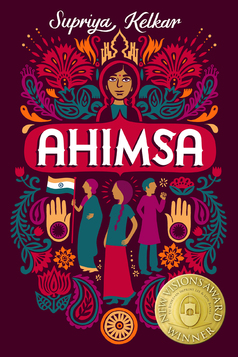TEACHER'S GUIDE FOR:
Ahimsa
By Supriya Kelkar
Illustrations by
Discussion Questions for Ahimsa by Supriya Kelkar
- What is ahimsa? How is ahimsa central to Hinduism and the Indian freedom movement?
- What was the Quit India movement? What groups of people were involved? How was it started and what was the goal?
- What does it mean to “give one family member to the freedom fight”? Has your own family ever made sacrifices to support a larger social movement, or can you imagine a circumstance in which you would?
- One of the first things Anjali must do when her mother joins Gandhi’s movement is get rid of her foreign-made clothes in favor of home-spun cotton. Why might someone want to give up foreign-made clothes today, and how hard do you think it would it be to do?
- How does Anjali’s mother challenge traditional gender roles? How is she confined by them?
- How does Anjali confront and overcome her own prejudices? Can you think of a time when you were challenged on an assumption or prejudice that you held?
- Keshavji speaks of two fronts of the independence movement for India: standing up to the British, and becoming more equal internally in India. Why was it important for Indians to become more united and equal as a part of the freedom movement?
- What parallels do you see between Gandhi’s nonviolence movement and the Civil Rights movement in the United States?
- How did Hindu-Muslim tensions play a role in the partition of India? What implications of this tension do we see today?
- Describe the relationship between Captain Brent and Anjali. How does Captain Brent show respect for Anjali? How does Anjali use ahimsa to defend Captain Brent?
- What do you think became of Mohan after he left the city? How do you feel about him leaving?
- What similarities do you see between the way Dalit people were treated in India and the way impoverished people are treated in the United States? Do you think that the United States has a caste system?
Teacher’s Guide Features:
- Summary and background information
- Prereading focus questions
- Vocabulary Discussion questions
- Ideas for literature circles
- Ideas for reader’s response and writing activities
- Strategies for ESL/ELL
- Interdisciplinary activities and connections
DOWNLOAD THIS GUIDE AS A PDF.

About This Title
Guided Reading:
ZLexile:
830LInterest Level:
Grades 3 - 7Reading Level:
Grades 3 - 7Themes
Asian/Asian American Interest, Childhood Experiences and Memories, Civil Rights Movement, Collaboration, Conflict resolution, Cultural Diversity, Discrimination, Dreams & Aspirations, Education, Empathy/Compassion, Families, Friendship, Gratitude, Heroism, History, Home, India, Informational Text, Integrity/Honesty , Kindness/Caring, Leadership, Mentors, Mothers, Muslim/Muslim American Interest, Overcoming Obstacles, Persistence/Grit, Poverty, Pride, Protest, Realistic Fiction, Respect/Citizenship, Responsibility, Teen Interest, Tolerance/Acceptance, War, YA interest
Collections
MG/YA #OwnVoices Collection, MG/YA Community Collection, Human Rights Collection, Social Activism Collection Grades 6-8, Women's Text Set Collection Grades PreK-8, Women's Text Set Collection Grades 6-8, Teaching Tough Topics with Children's Literature Webinar, EmbraceRace Webinar: Books That Encourage Inclusivity and Empathy, English Fiction Grades 3-6, Historical Fiction Grades 3-6, English Fiction Middle School, Social and Emotional Learning Collection, Perspective-Taking Collection, Social Activism Collection, Trauma-Informed Collection, Asian American English Collection Middle School, India Culture and History Collection, Anti-Racism Book Collection, High-Low Books for Teens: Middle and High School
Want to know more about us or have specific questions regarding our Teacher's Guides?
Please write us!general@leeandlow.com











